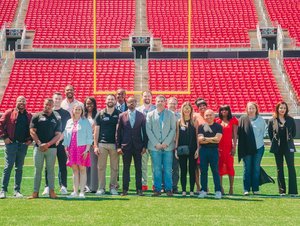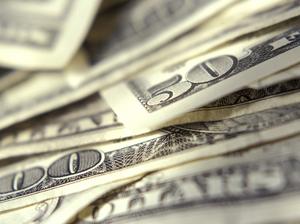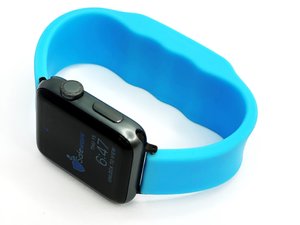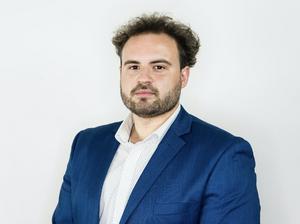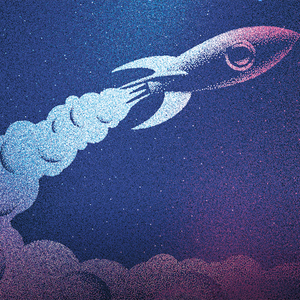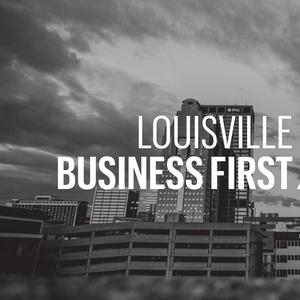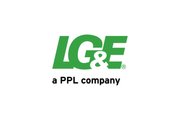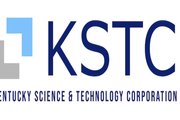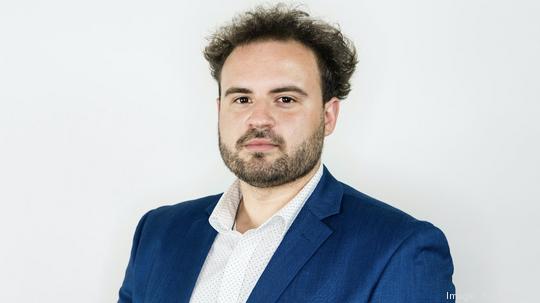
The day has finally arrived. After years of development — and more than 12 months after its soft launch — a Northern Kentucky wearables startup is now on the market.
Safewave Technology made its official debut Monday, May 6. The company’s smart wristband connects via Bluetooth to fire alarms, Ring cameras, security devices and more — essentially turning any at-home notification or alert into a vibration you can feel. The company is targeting those who are deaf or hard of hearing, but there’s also a use case for those with dementia, Alzheimer’s and special needs.
The startup will initially focus on selling direct to consumers. The bands are now for sale on the Safewave website. Retail price is $250, and the band pairs with the company’s app, which is free.

It’s also working to build a business-to-business pathway behind the scenes (the product could be carried, for example, at audiologist’s offices). All in all, the launch kick starts a new chapter for the company, founder Trevon Bruch said, one that also includes a move to new office space and a fundraise that could follow in close pursuit.
“It feels good. We're definitely celebrating it, but we know this is literally just the start,” he told me. “We have a lot more we can create. We’ve built the business. Now we have to run the business, which is a whole other skill set and challenge.”
Safewave’s founding story dates back 2018 when Bruch was awakened by a fire alarm. Everything ultimately checked out, but it got him thinking, what if? What if he hadn’t heard it and something was seriously wrong? Or what if he was deaf (he isn't), what tools would be available?
His initial research yielded very few results. Bruch said it was Zac Strobl, director of Northern Kentucky University's Center for Innovation & Entrepreneurship, who encouraged him to pursue the concept for a wristband in 2019.
In terms of market size, about 15% of the U.S. population is deaf or hard of hearing, which totals 48 million people. Worldwide, that number is 466 million – a figure that’s expected to rise to 900 million by the year 2050.
Add in its other target demographics and Safewave’s total addressable market is massive – an estimated 1.3 billion people experience significant special needs, while dementia and Alzheimer's impacts about 60 million and 40 million, respectively.
With Safewave, users can customize the number and pattern of vibrations. The band includes an adapter piece and is compatible with an Apple or Google watch face. The soft launch led to a number of improvements. Larger internal motors, for one, help power the device.
"It’s now way stronger than an Apple Watch vibration,” Bruch said. “We also added a power button, which helps with efficiency. The goal now is to keep rolling and get to the second generation, the third generation the fourth generation.”
No longer remote: Safewave adds office space in Covington
Leading up to the launch, Safewave moved into new digs in Covington along Pike Street. Prior, the team had bounced around between at-home offices, Starbucks coffee shops and an NKU-operated space also on Pike Street.
“It gives us a place for the team to come together and hyperfocus,” Bruch said.
He and Safewave co-founder, Jared Gabbard, are currently the only full-timers, while the company also employs a part-time developer and engineer. Bruch hopes to grow the team to eight by the end of the year.
For its rollout, Safewave will rely heavily on influencer marketing. It has a partnership with Matt Maxey, founder of Deafinitely Dope, an American Sign Language interpreting brand that helps deaf and hard-of-hearing fans enjoy live music. Maxey has toured with Chance the Rapper, among other artists.
Bruch considers it the most authentic way to connect with his target customers.
“It’s about building trust, especially as a hearing person. They can tell I'm not hard of hearing, that I'm not in this club. It’s almost like, ‘Who let you into this party?’” he said. “The community is very big on word-of-mouth, and when it comes to word-of-mouth, the quickest and most effectively way to grow is social media.”
Safewave is looking to sell its first 1,000 units over the course of the next 30 to 60 days. That will bring in $250,000 in gross revenue – a needed cushion, he said, to build a stronger foundation.
To date, the company has largely been self-funded. It did raise $90,000 in pre-seed funding in 2022 from Keyhorse Capital, which funds Kentucky companies, and private investors; and in 2023, it landed a Main Street Ventures Leap grant. MSV typically disperses between $10,000 to $30,000.
The hope is sales numbers are strong enough to roll into a $2 million seed-level fundraise.
“The first 1,000 (units are) crucial,” Bruch said. “We'll finally have data. We're going to have information we can play with and metrics to go off of. But we already know there’s global potential. That helps play into the vision of what we're trying to create.”
